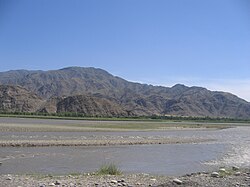Chitral River
| Chitral River Kunar | |
|---|---|
 | |
 Course of the Chitral River | |
| Location | |
| Countries | Pakistan and Afghanistan |
| Provinces | Khyber Pakhtunkhwa (Pakistan) (Afghanistan) |
| Physical characteristics | |
| Source | Hindu Kush Mountains in Chitral |
| Mouth | Kabul River |
• location | Jalalabad |
| Length | 480 km (300 mi) |
| Basin size | 26,000 km2 (10,000 sq mi) |
| Basin features | |
| Tributaries | |
| • left | Shishi River |
| • right | Lotkoh River, Landai Sin River, Pech River |
The Chitral River,[a] also known in Afghanistan as the Kunar River,[b] is a 480 kilometres (300 mi) long river in northern Pakistan and eastern Afghanistan. It originates from the Chiantar glacier, located at the border of Gilgit Baltistan and Chitral in Pakistan. At Arandu it enters into Afghanistan, where it is called the Kunar River.[1] It later merges with Kabul river in Nangahar Province of Afghanistan. The river system is fed by melting glaciers and snow of the Hindu Kush mountains. The Chitral River serves as a major tributary of the Kabul river, which is in turn a tributary of the Indus River in Pakistan.[2]
Origin and course of flow
[edit]The river rises in the far north glaciated Hindu Kush mountains of Chitral, Pakistan, where it is referred to as Chitral river.[3] Around 60% to 70% of annual discharge of Kunar river originates from Chitral.[4] Downstream as far as the town of Mastuj, it is called as the Mastuj river, till its confluence with the Lotkoh river.[5] Kunar then turns southwards into the upper Kunar Valley of Afghanistan. At the confluence in Asadabad, it meets with Pech River and finally empties into the Kabul River just to the east of the city of Jalalabad in Afghanistan.[3] The combined rivers then flow eastwards into Pakistan again, and joins the Indus River at the city of Attock.[3]

See also
[edit]References
[edit]- ^ Rahman, Atta-ur-; Shaw, R. (2014). "Floods in the Hindu Kush Region: Causes and Socio-Economic Aspects". In Nibanupudi, Hari Krishna; Shaw, Rajib (eds.). Mountain Hazards and Disaster Risk Reduction. Japan: Springer. p. 37. ISBN 978-4-431-55242-0.
- ^ The Afghan War, 1838-1842: From the Journal and Correspondence of the Late Major-General Augustus Abbott, editor Charles Rathbone Low, publisher R. Bentley & Son, 1879, Google Books
- ^ a b c Ahmad, Mahmood (2023-09-26). Water Policy in Pakistan: Issues and Options. Springer Nature. p. 327. ISBN 978-3-031-36131-9.
- ^ Watto, Muhammad Arif; Mitchell, Michael; Bashir, Safdar (2021-03-25). Water Resources of Pakistan: Issues and Impacts. Springer Nature. p. 45. ISBN 978-3-030-65679-9.
- ^ Pakistan & the Karakoram. Lonely Planet. 2008. p. 233. ISBN 9781741045420.
Further reading
[edit]- Allan, Nigel J. R.; Buddruss, Georg (1991). "CHITRAL". Encyclopaedia Iranica, Vol. V, Fasc. 5. pp. 487–494.
